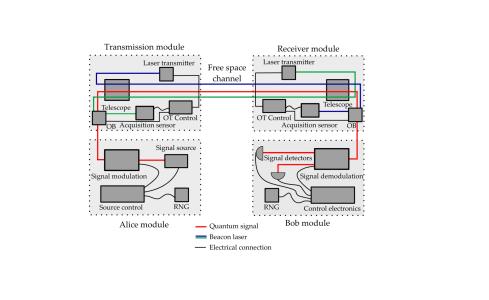Advances in Technological Quantum Optics

Commonly used classical cryptographic protocols, such as the RSA-protocol, rely on the hardness of computational problems. With the advent of quantum computing (QC), the hardness assumptions of these problems is nullified, since they can be solved efficiently on a QC. On the other hand, the security of Quantum key distribution (QKD) rests upon the very laws of physics and guarantees information-theoretic security, which not only enables tap-proof communication at present, but also prevents any future technology to crack encrypted messages. Any attempts of a malicious eavesdropper to gain information about the exchanged key shared between two authorized parties, called Alice and Bob, can be detected. The secret key used to encrypt messages is extracted from measurements of quantum states which are shared between Alice and Bob. At present, QKD implementations rely on photons as quantum information carriers. Long-distance distribution of photons is hindered by losses in optical fiber transmission, which, in contrast to classical signals, cannot be amplified. Satellite-based solutions can enable the exchange of secure keys over distances unattainable for fiber-based transmission. The transmission loss for free-space links is dominated by diffraction rather than absorption, which circumvents exponential losses in terrestrial distribution of photons and enables QKD on a global scale. In this project, the definition of relevant components of satellite-based QKD systems is developed. Most QKD systems comprise similar components, which include photon sources, transmitting/receiving optics, detectors and data processing hardware. Standardization efforts to improve interoperability and efficient system-planning require the identification of building blocks and relevant properties. While standardization documents have been developed for in-fiber QKD systems by NIST1 , TIU2 and ETSI3 , the imminent deployment of a satellite-based quantum communication infrastructure demands an established standard as well which is yet to be developed. The main part of this project is devoted to advances in satellite-based QKD and techniques for increasing the key rate while simultaneously making the operation and deployment of quantum payloads more efficient and practical. All of the presented advances are focused on entanglement-based QKD with discrete variable (DV) encodings, since they offer the highest level of security. While continuous variable (CV)-QKD is suitable for certain scenarios, the nonexistence of security proofs for the losses expected in global quantum networks renders CV encodings impractical. Despite the existence of mission proposals for prepare and measure QKD, entanglement-based protocols are preferable for two main reasons. Firstly, the satellite is an untrusted party in this scenario and can be owned by anyone without compromising the security and secondly, entanglement is itself a valuable resource which is essential for current and future quantum technologies.
